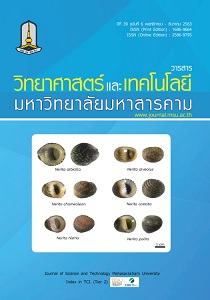Coronaviruses : Biological Disasters from SARS and MERS to COVID-19
Main Article Content
Abstract
Coronaviruses are viruses causing diseases both in human and animals. There are 7 strains reported to capable of causing diseases in human including HKU1, NL63, 229E and OC43. These strains are causative agents for common cold having mild symptoms that can be alleviated by supportive care. The other 3 strains, SARS-CoV, MERS-CoV and SARS-CoV-2, are mutated strains derived from animal infected coronaviruses. Since human bodies have not been exposed to and have had no immunity to these novel viral strains, they cause serious diseases in human including SARS, MERS and COVID-19. Moreover, these 3 coronaviruses spread worldwide, kill many lives and enormously damage global economy. Therefore, they are considered to be biological disasters worse than wars. This paper gathers information from many publications about coronaviruses especially the 3 novel strains spreading worldwide to demonstrate their relationship. Having no intention to give profound information in any aspect, this paper is readable and comprehensible for general public.
Article Details
References
2. Graham R, Donaldson E, Baric R. A decade after SARS: strategies for controlling emerging coronaviruses, Nat Rev Microbiol 2013;11(12):836-848.
3. Singhal T. A review of coronavirus disease-2019 (COVID-19), Indian J Pediatr 2020;87:281-286.
4. Jiang S, Lu L, Liu Q, Du L. Receptor-binding domains of spike proteins of emerging or re-emerging viruses as targets for development of antiviral vaccines, Emerg Microbes Infect 2012;1(8):e13.
5. Li F. Structure, function, and evolution of coronavirus spike proteins, Annu Rev Virol 2016;3(1):237-261.
6. Shang J, Wan Y, Liu C, Yount B, Gully K, Yang Y, Auerbach A, Peng G, Baric R, Li F. Structure of mouse coronavirus spike protein complexed with receptor reveals mechanism for viral entry, PLoS Pathog 2020;16(3):e1008392.
7. Cui J, Li F, Shi Z. Origin and evolution of pathogenic coronaviruses, Nat Rev Microbiol 2019;17(3):181-192.
8. Song Z, Xu Y, Bao L, Zhang L, Yu P, Qu Y, Zhu H, Zhao W, Han Y, Qin C. From SARS to MERS, thrusting coronaviruses into the spotlight, Viruses 2019;11(1):59.
9. Yi Y, Lagniton PNP, Ye S, Li E, Xu RH. COVID-19: what has been learned and to be learned about the novel coronavirus disease, Int J Biol Sci 2020:16(10):1753-1766.
10. Cherry JD, Krogstad P. SARS: the first pandemic of the 21st century, Pediatr Res 2004;56(1):1-5.
11. Mubarak A, Alturaiki W, Hemida MG. Middle east respiratory syndrome coronavirus (MERS-CoV): infection, immunological response, and vaccine development, J Immunol Res 2019;2019:1-11.
12. Prompetchara E, Ketloy C, Palaga T. Immune responses in COVID-19 and potential vaccines: lessons learned from SARS and MERS epidemic, Asian Pac J Allergy Immunol 2020;38(1):1-9.
13. Shereen A, Khan S, Kazmi A, Bashir N, Siddique R. COVID-19 infection: origin, transmission, and characterization, J Adv Res 2020;24:91-98.
14. Guo Y, Cao Q, Hong Z, Tan YY, Chen SD, Jin HJ, Tan KS, Wang DY, Yan Y. The origin, transmission and clinical therapies on coronavirus disease 2019 (COVID-19) outbreak-an update on the status, Mil Med Res 2019;7(1):11.
15. Ji W, Wang W, Zhao X, Zai J, Li X, Homologous recombination within the spike glycoprotein of the newly identified coronavirus may boost cross-species transmission from snake to human, J Med Virol 2020;92(4):433-440.
16. Fineberg H. Pandemic preparedness and response-lessons from the H1N1 influenza of 2009, New Eng J Med 2014;370(14):1335-1342.
17. Chen Y, Guo Y, Pan Y, Zhao ZJ. Structure analysis of the receptor binding of 2019-nCoV, Biochem Biophys Res Commun 2020;525(1):135-140.
18. Otter J. Considering the role of environmental contamination in the spread of COVID-19, [online] 2020, March 12. Available from: https://reflectionsipc.com/2020/03/12/considering-the-role-of-environmental-contamination-in-th e-spread-of-cov id-19/#more-4502. Accessed 30 April, 2020.
19. Yuen KS, Ye ZW, Fung SY, Chan CP, Jin DY. SARS-CoV-2 and COVID-19: The most important research questions, Cell Biosci 2020;10:40.
20. Liu R, Han H, Liu F, Lv Z, Wu K, Liu Y, Feng Y, Zhu C. Positive rate of RT-PCR detection of SARS-CoV-2 infection in 4880 cases from one hospital in Wuhan, China, from Jan to Feb 2020, Clin Chim Acta 2020;505:172-175.
21. Chung M, Bernheim A, Mei X, Zhang N, Huang M, Zeng X, Cui J, Xu W, Yang Y, Fayad ZA, Jacobi A, Li K, Li S, Shan H. CT imaging features of 2019 novel coronavirus (2019-nCoV), Radiology 2020;295(1):202-207.
22. Radiological Society of North America. CT provides best diagnosis for COVID-19. [online] 2020, February 26. Available from: http://www.sciencedaily.com/releases/2020/02/200226151951.htm. Accessed 30 April, 2020.
23. Chan KW, Wong VT, Tang SCW. COVID-19: an update on the epidemiological, clinical, preventive and therapeutic evidence and guidelines of integrative Chinese-Western medicine for the management of 2019 novel coronavirus disease, Am J Clin Med 2020;13:1-16.


